Pickling has been a food preservation technique for centuries. It is the process of preserving fresh foods in a vinegar solution to make them last longer and take on a briny flavor.
While we know pickling works for saving our excess produce, what would happen if meat were to be soaked overnight in vinegar?
The process of soaking meat in a briny solution overnight is typically referred to as brining or marinating. Often, the marinade is made from vinegar or acid, oil, and lots of seasonings.
We all know this brings flavor to your meat, but what does a 100% vinegar solution do to meat overnight? First, we need to dive into the science behind vinegar and why it is used for curing, preservation, and tenderizing.
Related: Making Raw Apple Cider Vinegar at Home
Why Use Vinegar?
Vinegar is made of mostly acetic acid, which is an acid that acts as a self-preservative due to natural fermentation between the acid and sugars or ethanol. It inhibits bacteria growth, making it ideal for pickling and preserving. Foods preserved in vinegar can last for years without spoiling.
The acetic acid in vinegar increases the acidity of whatever is submerged in it, killing off any microorganisms. This creates the preserving effect. Without microorganisms, bacteria cannot multiply in an acidic environment.
Vinegar also helps to weaken collagen in meat, allowing those connective tissues to tenderize. By the time you are ready to cook the meat, the vinegar will have done its job. The ideal result is a shredded texture that melts in your mouth with a slightly acidic flavor.
Popular cured meats are often cured with vinegar. For example, chorizo is cured with vinegar before cooking. It provides a lastability that cured meats require. Vinegar also gives chorizo its unique acidic, umami flavor.
We all know how well vinegar works for preserving vegetables, so I want to see exactly what happens when a piece of meat is soaked in vinegar overnight. Does it change the flavor? The texture? Does it inhibit the growth of bacteria in the same way as vegetables?
Here is the experiment to find out the answers to these questions.
The Experiment
To find out exactly what vinegar does to meat, I had to choose an optimal cut of meat to brine. Chicken tends to take on flavors extremely well, however, the goal is to be able to eat the meat after the soak. A heavier cut of meat is the way to go.
I settled on a delicious, locally-raised bone-in pork loin chop. This high-quality cut of meat is perfect because it is heartier than chicken but not intensely flavored like a cut of beef.
Related: How To Preserve Beef in Glass Jars
I also wanted to choose a smaller cut of meat since the soaking time is to be 12-24 hours long. If the vinegar can preserve and penetrate this smaller roast overnight, perhaps a larger cut may soak a little longer.
There are a ton of varieties of vinegar, all of which bring something different to the table. For this experiment, I kept it simple with classic distilled white vinegar.
Folks following this recipe likely have a large bottle of distilled white vinegar laying around. With a neutral flavor and 5-6% total acidity, white vinegar is the way to go for your first time.
Meat in Vinegar Recipe
We have our meat and our vinegar picked out, so now it is time to combine them.
For this recipe, you will need:
- 1-1,5 lbs. pork loin chop, bone-in
- 2-3 cups of distilled white vinegar
- 1 tablespoon oil, for frying
- 1 teaspoon salt
- One teaspoon pepper
- A glass or non-reactive baking dish/bowl
- Plastic wrap
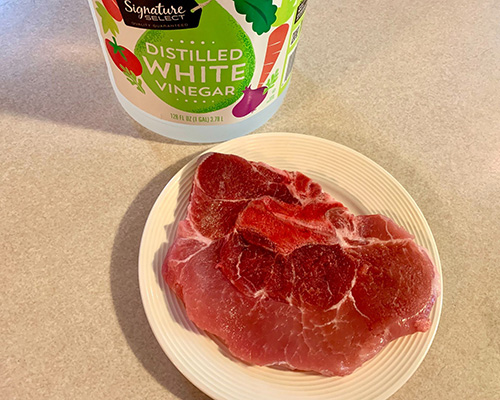
Begin with your pork. Add it to a glass or non-reactive dish. I used a baking dish since it was flat and fit the meat nicely.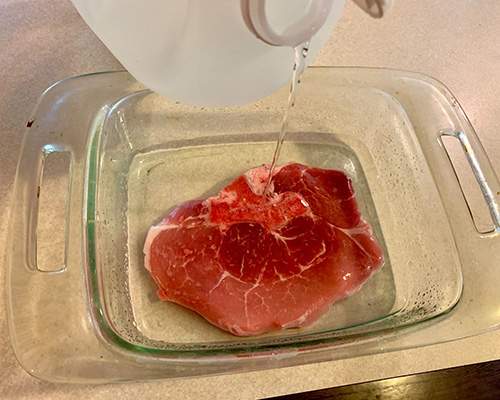
Pour the vinegar over the meat until the meat is completely submerged. You will need more or less, depending on the size of your meat.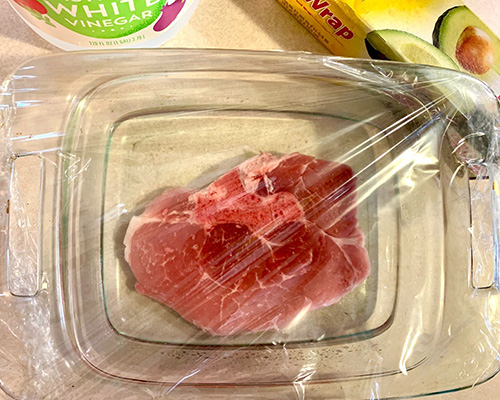
Cover with plastic wrap or a lid and place in the refrigerator overnight, 12-24 hours.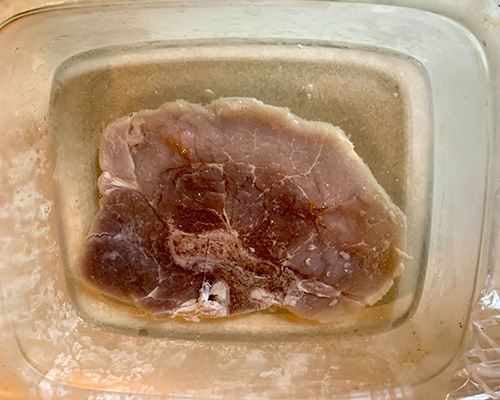
After 12-24 hours, your meat will have lost all of its original color. My pork was originally a beautiful pink color, but after soaking it became slightly grey and dull. Also, the meat seemed to have changed textures.
It went from raw meat to jellied during its overnight soak, which was unexpected.
After the overnight soak, remove the meat from the vinegar. Pat dry with paper towels to remove surface-level moisture. Your pork will have a strong vinegary smell with no notes of raw meat.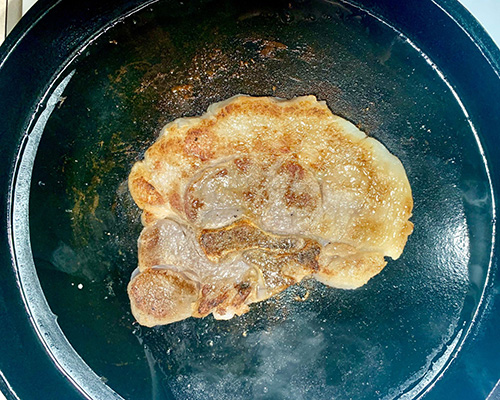
Next, it’s time to cook the meat. In a large cast-iron skillet, add 1 tablespoon of oil and turn the heat to medium. Allow the skillet to get hot before adding the pork.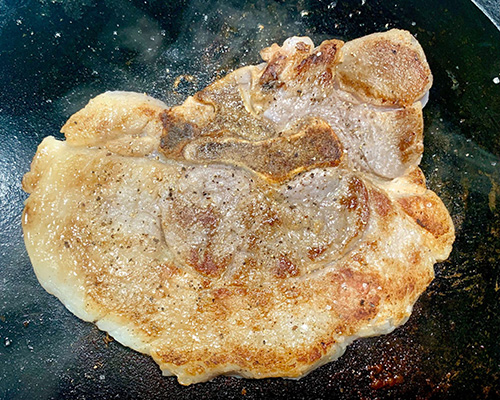
Sear the pork and cook about 5-6 minutes per side until well-done. The meat will smell intensely briny when cooking.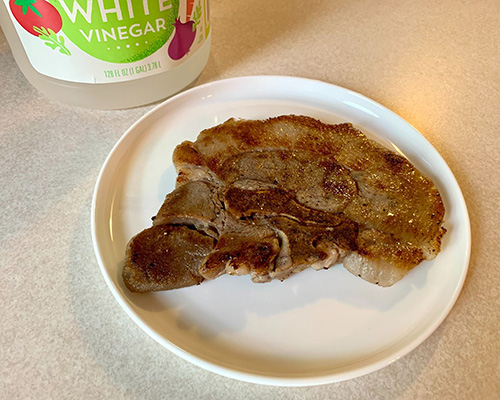
Remove from the heat when the internal temperature reaches 145 degrees Fahrenheit. Allow the meat to rest for about 5 minutes before slicing and serving.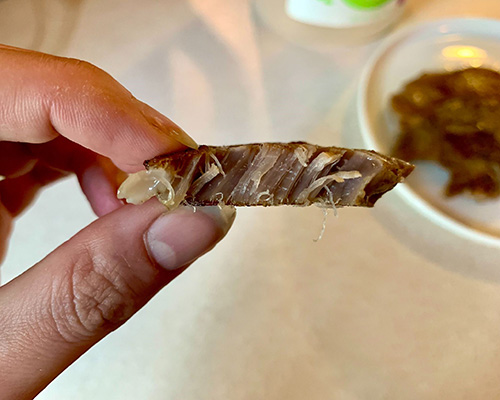
Tasting the Results
Surprisingly, the flavor of the vinegar-soaked pork was fantastic. The meat was extremely tender and shredded apart as I ate it. It was reminiscent of wiener schnitzel or sauerbraten because the meat was acidic and flavorful.
The jellied texture of the raw meat was a roadblock that I thought might derail the entire experiment. To my surprise, the meat exhibited no jellied consistency. In fact, the texture of the cooked meat was spectacular. This was one of the most tender pork loin chops that I have ever cooked before!
In terms of vinegar preventing spoilage on the meat, the results are hard to conclude. When uncovering the pork from the brine for the first time, I gave it the smell test.
Related: How do You Keep Your Pantry Dry to Prevent Your Food from Spoiling?
Aside from being extremely potent with vinegar, there was no smell of raw pork whatsoever. With eyes closed, you would not know that you were sniffing raw meat. While that does not mean too much for detecting spoilage, it is a start. A longer brine may yield different results in the future.
It is safe to conclude that soaking your meat in vinegar overnight not only adds great flavor but also adds wonderful texture and is a reliable way to prevent bacteria growth.
Different meats and different types of vinegar may bring on different flavors and results. The base flavors of pork and white vinegar work well together and are affordable, making this experiment great for anyone who would like to recreate it.
Meat in Vinegar
In this experiment, we set out to find out what happens if you soak your meat in vinegar overnight. It was found that soaking pork in white vinegar for 12-24 hours flavored, tenderized, and prevented bacteria growth in the meat.
Your pork may develop a grey color and jellied texture upon soaking but do not give up there. Searing and cooking the meat yields a more appealing color, ridding the meat of its greyishness.
If you are a fan of vinegar and briny dishes, you will be a fan of the meat’s flavor and aroma. To preserve meat in the future, do not hesitate to utilize vinegar.
Soak your meat for up to 24 hours for optimal flavor and texture. The experiment was worth it and I found it to be a useful technique for processing meats cheaply and effectively.
You may also like:
Black Seed – The Remedy For Everything But Death
How To Use The Bark Of This Common Tree To Keep Your Meat From Spoiling (Video)
How To Dehydrate Milk For Long Term Storage
Best Household Self-Defense Items You Probably Have In Your Home Right Now

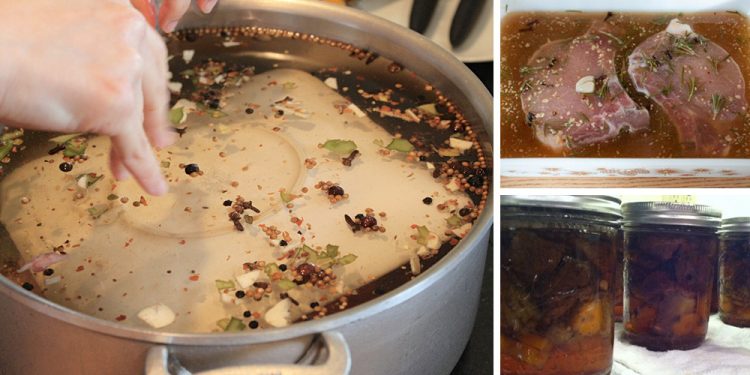
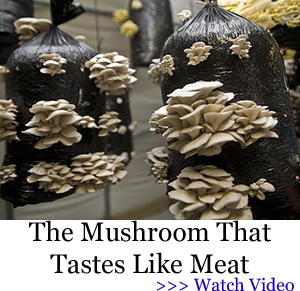




















How long will the meat last after it comes out of the brine. ?
Do you have to keep in the frig or can it just stay out. ?
Do you have to cook it or can it be ate with out being cooked.?
How would or will you store it.?
seem to be another way to have some kind of meat for survival.
Good to know… Thanks.
By the way, all “red” meats sold today are the color they are due to dyes. The dyes are broken down by the vinegar, and the resultant grey color is what color the meat really is (undyed).
Guy, actually meat that is aged about 10 days to 2 weeks IS greyish brown, yes- but, only on the ourside. The inside of the cut will still be redish/brown. Markets in WA state got into trouble in the 70s or so, for putting pretty red burger around the brownish burger in the middle of the pkg.
But, there is nothing wrong with brownish meat. Except right now it’s making me hungry!
Good Questions Red Ant…I have questions and concerns as well.
I am only the messenger, please don’t kill the messenger.
Most people know what I am going to say, but not as many have been intensely exposed to the science behind pathogens. I am no expert, but I am much more knowledgeable than I was a few decades ago.
I do not deny that vinegar has some very good pickling properties for vegetables and meats, and this article expounds on that. Most “known” pathogens cannot survive in an acidic environment.
I am not a doctor…but part of my career for five years was directly related to agriculture veterinary science in a professional setting. And way back when…growing up on a ranch, I thought I pretty much knew what pathogens were out there infecting our cattle. How I survived, I do not know.
There are many zoonotic pathogens that can be transmitted to you from live animals, as well as from their raw or undercooked meat. And with the over-use of antibiotics, previously “unknown” superbugs are now surfacing in places not ever found before.
YES, This is a VERY GOOD article, definitely worth keeping for future reference. But please be careful when experimenting because numerous pathogens including virus, bacteria, and parasites are found regularly in fish & shellfish, including in sushi and sashimi (uncooked raw fish).
Pathogens are also commonly found in pork, sometimes Trichinella worms, and several different types of very serious bacteria.
Meat and other foods including water requires a certain level of sustained heat to kill ALL pathogens. You will not like to hear this…but we eat dead pathogens in our cooked meat all the time.
Yes, acidic chemicals like vinegar can destroy many viruses, bacteria, and parasites that may be found in the food or water, but folks…boiling or sustained heat with temperatures over 150 degrees is really the only guarantee. The last few times I cooked a turkey, it always came out a little tough…but I would rather eat dead salmonella…yuck, sorry about that.
J Quest, your comments are very true. I was a QA Technician for a Coca-Cola bottle manufacturer for over a decade and taught Chemistry and Biology for the last 5 years. I did a lot of research and training on pathogens, both viral and bacterial. Our bodies are made of large quantities of bacteria and we carry viruses all the time. Most of them are necessary for life as we know it. Animals and the same. When we consume meat, we don’t only consume the animal, we also consume what lived in them and what they ate. It’s only “gross” if you think of the bacteria macroscopically. On a whole, you ingest more bacteria, yeasts, and molds just by breathing than you do from eating meat. The important thing to know is that the dangerous microscopic organisms need to be dead and cooked well before eating. This is the point of pasteurization and the importance of cooking meat to the correct core temperature for the appropriate amount of time. Acids work well to destroy bacterial cell walls, but this is not always the case. Do your research on what potential pathogens are not hindered by acidic environments.
This was a really good article. It made lots of good points and I think I’m going to try some new overnight marinades. Good luck to everyone. And remember that knowledge is power.
@ J Quest
Thanks for the info. we need all the info that we can pack in our heads.
Keep the INFO coming…
J. quest: I think I’m jealous of your knowledge. (joking 🙂 Why aren’t you posting more? You were raised in aggie, a rancher, and that means as my grandparents taught, quick on the brain or quickly dead.
My parents were adamant, pink in meat means it’s not done cooking. When we got in a load of feeder pigs or calves, they went in a pen and were watered out of a copper tank for a few days. All manure was burned. that took care of worms, even liver flukes. A little (very little) zinc took care of viral infections from the sale barn. He bought a load of feeder pigs that shortly after showed sign of scabies. He started to treat them with used motor oil but one escaped into the heard up on the mountain. he brought the herd down to a hay field and we knocked together a summer shelter, then he wrapped burlap around a rope and hung it horizontal over the doorway. It was low enough sows had to crawl under it to get out of the sun. they figured it out and would walk back and forth, and rub against the door posts he soaked with fresh oil every day. No more scabies. Kerosene works as well. None got on the cattle, thank God. niio
Hey Red, Thanks…ya, I learned back then and still learn now.
I do read here often, and learn a whole lot on this site.
We were all kids once…
Getting bit by a wild animal (not a rabid skunk, I was a dumb kid, but not that dumb) and forced to get a 14-day series of rabies shots was one of the worst things that happened to me. Rabie’s is obviously a bad zoonotic disease, and I was very careless as a gungho teenager. I was probably fine, but…
I was cutting an alfalfa field and hit a nest of rabbits, the babies were running everywhere, the mother looked dead…I got off the tractor thinking it was dead (going to remove it from the alfalfa before baling) and foolishly picked it up, it bit me real good on the finger, I dropped it and it ran off. So…take the shots or possibly die of rabies…ouch, ouch, ouch…
One of most surprising things I have learned a few years ago is about the Opossum. It carries some really bad pathogens. There is one called EPM, for all you horse owners, keep Opossums away from your property, those parasites can kill a horse, and you will not know it is sick until almost too late. The most common way it infects your animals, the Opossum is thirsty, at night it climbs up and drinks out of the water trough, the water is now contaminated.
And those little things just keep on ticking, I saw one get hit on the farm road…it laid there “playing dead” for a couple minutes, then got up and wobbled off. Trap them and carefully dispose of them. Do not handle them.
Birds carry some nasty pathogens too, ever heard of the Bird Flu. Hire a cat for your barn, serves double duty…keeps birds away, and kills rodents…no rodents, no snakes.
Yellow Jacket Wasps are no fun, get rid of their paper nests ASAP. But don’t kill the Mud Dauber Wasps. Open up one of their Mud Nests, you may find dozens of live paralyzed spiders, food for the baby when it hatches…I don’t care much for spiders & snakes…So I hired a cat and allow Mud Daubers to nest in certain spots, not next to a door…lol.
J. Quest:
The secret to a fantastically tender and juicy turkey is to rub the bird with seasoned oil or mayonnaise and to cook at 350°F until you can tug on the leg and have the bone come out clean in your hand.
Roast breast side down and cover the wings and drumsticks with foil. Uncover them the last hour so they get crispy if they aren’t already.
It usually takes twenty minutes per pound and add half an hour or so if you start it in a cold oven. Use the poke test to see if the juices are still pink only towards the end of the cooking time because you will dry out the meat.
Mayo is good because the vinegar and oil baste the meat and the eggs form a thin crust or glaze that keeps it moist. I use this for chicken as well.
Also, NEVER bake the dressing inside the bird…it will take longer to roast the meat and is a breeding ground for pathogens. Plus you have to remove it right away anyway to cool the meat and if you want to use the bones for soup…bake it separately with pan drippings if you want the same flavor. I use stove top…fast and easy and it tastes great. Also no eggs needed for binding it.
I wouldn’t leave it out. Even sauerkraut (cured in straight venegar) should be refrigerated when opened.
Yes, you can cook the meat in order to preserve it. That’s a double whammy preserve. As far as freezing without cooking is iffy to me as there are some acidic foods that do NOT freeze well at all. I will be experimenting with a very small piece of meat for that.conclusion.
Good lck.
Jenny: vinegar will kill the probiotics in the cabbage. Cut and pack it. If you have funny water (like ours, plenty of copper) then keep it topped with distilled water. A week to ten days at 80 F or more will turn sugar in the cabbage to vinegar. But, the probiotics will continue to soften the kraut. We save the extra juice to drink, and it can stay on the counter for several days. Meat, tho, I would refrigerate it till it’s cured. Without salt, it all freezes well and we’ve had kraut over a year old out of the freezer. Pickled meat, tho, tend to evaporate 🙂 niio
Danger Will Robinson: exactly, this is not an experiment to test if the vinegar killed bacteria because the meat was placed in the fridge. That’s why a lot of food is put in the fridge to mitigate the multiplication of bacteria in a food item. To test for the effectiveness of killing bacteria, the meat sample should have been left out, in the vinegar, for at least several days and then proceeded with the experiment. But folks, you need to be careful when experimenting on substances that might curtail the growth of organisms unless you are in a lab setting and have the equipment to test for the growth of bacteria. You are playing with your health and your life if you don’t follow standard science/safety protocols!!
Randy: amen to that. If there are rats around, animals will pick up and pass on any diseases they carry even if not affected by them. And there are always rodents around livestock. niio
Good pictures.
Interesting, thanks. If I am not mistaken there is actually a way to cook meat, with no heat, using vinegar. I forget what it’s called but I’ve eaten it before … pickled garr or carp I think it was and it was actually good.
Saviche, seafood, cooks in acid such as lemon juice or vinegar and is quite popular. It isn’t cooked with heat at all.
Personally I’d soak the meat in a refrigerator or at least a cool place. I’d expect the picking process to extend the safe useabIe time for meats.
Native communities shared large game among the family and or community and dry some for the future.
Any way to save meats a little longer while you’re eating it up is a good thing. I may try this idea. We’re mostly eating food from a community pantry right now. I pick it up twice a month. I’ve been canning what we aren’t going to eat before it would spoil. If pickling will add a little extra time I’ll try it. Then we can be eating from it longer. I know it works great to tenderize tough cuts of meat.
That was fish, Gallo, not pork or beef. Fish is already tender to begin with. You’ve heard of sushi. That’s basically small pieces of bait. As beef doesn’t contain any pathogens I would be willing to try your way with beef but sure as heck not with pork. Even today pork CAN contain a large number of parasites. You must’ve heard of steak tartare, Gallo. Basically minced raw beef with spices in it. My uncles used to eat it. I won’t touch it. They both had heart problems. Here are SOME of the things you can put into it:
3 tbsp. extra-virgin olive oil, plus more to taste
1 egg yolk
3 tbsp. salt-packed capers, soaked in water, rinsed, and drained
2 tbsp. minced flat-leaf parsley
1 small red onion, minced
1 red thai chile, stemmed, seeded, and minced
Fleur de sel and freshly ground black pepper, to taste
Sherry vinegar, to taste
Dijon mustard, for serving
my wife makes something called kinilaw, which is a Filipino version of ceviche, by marinating / cooking raw fish by soaking in a mixture she makes with vinegar, calamansi juice (lemon should work) , garlic, ginger, and whatever else she decides to add for flavoring. Then eating the kinilaw right out of the marinade without additional cooking. This recipe (the link is posted below) says you can do this with seafood, pork, beef, and deer, cut into bite sized pieces, but does not mention poultry. I think the fish would “cook” faster than other more solid meats would, so you may try this, including for poultry, for 12-24 hours, then try a very small bite to decide if it needs additional heated cooking in a pan or on a grill. I looked up “beef tartare / tar tar” to compare, and the tar tar recipe says its a recipe for serving raw beef, but did not mention if the beef gets cooked by chemical reaction, so I don’t think using a tar tar recipe would cook the beef like kinilaw. As always, test with a small amount first to see what works for you, but if you eat sushi or sashimi, then you will probably like seafood kinilaw.
https://www.thekitchn.com/kinilaw-recipe-23177759
dz: Looks good, thanks! niio
Sounds REALLY good, red. Now you’re making me hungry. Two of my favourite things. Sauerkraut and a good cut of beef. As always with beef, low and slow to break down the connective tissue. Just another way to marinate the meat before cooking. With sauerkraut I guess the correct term would be brining the meat instead of pickling it. Salt vs. vinegar. I like to also keep it simple. Just the basic spices. I’ve watched a u2b video by Martha S. showing how to properly braise a roast of beef. I have one of those electric pressure cookers with an insert so the product doesn’t touch the bottom of the vessel. Been dying to try braising a piece of beef with it. When Martha does it she uses a ceramic vessel to cook the meat for approx. 2-2 1/2 hours. Comes out so tender the knife just glides through it. Don’t see why it wouldn’t work in a pressure cooker. When it gets a little cooler will give me more incentive to try it. As always, appreciate your comments red. Peace, brother.
Armin: we don’t use salt to make kraut, but only pack it raw in jars, then add water as needed. Curing summer kraut works best at 80+ F. Bacteria convert sugars in the cabbage to a vinegar. That’s how we do sauerbraten, pickled beef. Say, a day per inch of thickness. This can be frozen for longer than you would fresh. Same with the salt-free kraut. It should be crunchy when cured and will stay crunchy in the freezer.
Termite, the mountain xolo we adopted, loved kraut, but discovered you do not drink white vinegar. He has a perverted love for plastic jugs, and stole 3 half-gallon jugs of white vinegar from the back porch. the last one he poked a hole in and got a taste, then dropped it. He never went back for the last one. niio
I know, I know. You’ll pickle your pecker. Hahahahahaahahahahahaha, yeah its Monday.
How old are you? 16? I’m surprised that your response wasn’t deleted.
Keep making comments like this because this entire world is about to experience things on a biblical scale. I can guarantee you won’t be making your juvenile responses then. Instead you will be begging people like us for food and help.
I like raw fish preferably a soft fish, in one can of coconut milk with onions, tomatoes,salt pepper,couple of caps of vinegar and a squeeze of lemon juice ( can add a small amount of curry, optional ). Put in the fridge,it will be ready in four to five hours but keeps for up too a haven’t tried canning it yet but might give it a go.
I like raw fish preferably a soft fish, in one can of coconut milk with onions, tomatoes,salt pepper,couple of caps of vinegar and a squeeze of lemon juice ( can add a small amount of curry, optional ). Put in the fridge,it will be ready in four to five hours but keeps for up too week a haven’t tried canning it yet but might give it a go.
I understand that the vinegar added flavor and tenderized the meat, but I thought the main subject of the article was preserving meat in the case where one doesn’t have refrigeration?
Since the meat was placed in the fridge for overnight marination, I didn’t understand why the sniffing it to detect possible spoilage was even done, since it had been in the fridge.
Seems like a good, simple way to make a tasty meal, but how did your example illustrate that the vinegar preserved the meat?
Wouldn’t that have been more convincingly illustrated if you had just set it out on a table and marinated the meat at room temperature overnight?
My thoughts exactly! nothing to do with preservation.
Yeah, I am wondering the same exact thing, your point is spot on Richard.
TRACY NAWARA, Did we miss something in your article?
Please clarify because your article was interesting, well written and the subject matter is highly relevant in these crazy times.
Thank You
Danger Will Robinson: exactly, this is not an experiment to test if the vinegar killed bacteria because the meat was placed in the fridge. That’s why a lot of food is put in the fridge to mitigate the multiplication of bacteria in a food item. To test for the effectiveness of killing bacteria, the meat sample should have been left out, in the vinegar, for at least several days and then proceeded with the experiment. But folks, you need to be careful when experimenting on substances that might curtail the growth of organisms unless you are in a lab setting and have the equipment to test for the growth of bacteria. You are playing with your health and your life if you don’t follow standard science/safety protocols!!
Hi, Next time you might want to try mixing 50/50 ratio of wine and vinegar. It lessens the bite of acid and the alcohol is also a preservative. That is often what is done with Sauerbraten and I have left meat on the counter for 3 days this way will no ill effects. (I also add garlic, onions, salt and pickling spices.)
Hurray! Someone finally mentioned sauerbraten. Good for you, PW. Wonderful way to cook a roast of beef. They usually do put it into the fridge for those three days. Just to be on the safe side. If you’re going through a particularly hot stretch then for sure put in into the fridge. Heck, I’ve eaten barbecued chicken that I’ve left out on the counter for two days in the summer. No ill effects. Personally I don’t know if I’d waste the vinegar marinating pork in it. Unless you want the vinegar taste in in. Then you could make sweet sour pork. Pork usually turns out pretty tender to begin with. If you want to able to cut your pork roast with a fork just braise it like you’d do with a roast of beef. When you braise your beef properly it turns out very, very tender.
Armin: Bury the meat in sauerkraut for 3 days to pickle it. We save the juice from homemade kraut in the fridge. It’s acid enough it doesn’t grow anything unpleasant. when the meat is cured, roasting pan, black pepper, some chopped garlic. Cover, slow roast till the meat is done. niio
I would be curious how long it lasted out of the fridge. The point was making it for long term storage, was it not?
Aren’t we basically talking Pickled Herring??????
Nope, we aren’t, JPup. You make pickled herring (and it is a WONDEFUL thing) to be able to preserve the herring for an extended period of time. Even the sealed jars are kept cool because it’s fish. All Tracy was trying to do here was to see what would happen when you marinated pork in vinegar anywhere from 12-24 hours. And then she wanted to cook and eat it right after. Her goal wasn’t preservation but tenderizing the meat.
Well, I’ll have to try this! Normally when I soak meat in vinegar, I add pickling spices, red wine, and soak it for 3-4 days, turning it each day. I’ll slowly pot roast it and then make a little gravy with some crushed gingersnaps.
Gingersnaps, are you from Koln? My father in laws sister always uses gingersnaps too. I’m from OberFranken and we always use a dark Roux, but we do add a little sugar. I’ve never tried the gingersnaps because my daughter has celiac disease so I make a gluten free dark Roux instead. If you’ve had both I’d love to hear a comparison.
PW- The only other versions I have tried are substitutions for the ingredients in the gravy along with the crushed gingersnaps, and that is using either a little tomato purée or a heaping spoonful of sour cream. You might consider adding ground ginger to taste to bring it up a notch as they say as a substitute for the actual gingersnaps. And yes, I do have Koeln roots on my mother’s side, going back many generations. Gute Appetite!
CC: Ich bin auf Dietchland (shh! don’t tell no buddy!) 🙂
If you don’t mind me asking, what is Koeln? niio
What you probably meant to say, red, is “Ich bin auch ein Deutscher”. Just like Kennedy said Ich bin ein Berliner. Köln means the city of Cologne. Because the US keyboard doesn’t have those two little dots that are over the “o” we have to approximate the sound of the “ö” by putting an “e” after the “o”. Just as an FYI those two little dots are called an umlaut mark ( ¨ ) used over a vowel, as in German or Hungarian, to indicate a different vowel quality, usually fronting or rounding.
Armin: Ich bin kein Deutscher. Ich bin Dietsch aus Nordosten Penn. It’s from alt kens, mountain German (Bavaria, Hess, and Thuringia), from over 200 years ago and mixed with English, American Indian, and God knows what else.
My stepmother, 2 aunts, and a mother-in-law were from Germany, war brides.
I’m a manuscript researcher and editor 🙂 niio
Cologne. Ones inserts an “e” if one does not use the umlaut. That’s probably why you see spellings that may not seem quite right to you Red.
Guten appetit. Prosit!
CC: do you add any liquid smoke? niio
Absolutely NOT! Prost! Oktoberfest!
Generally a good article, but as a chemist I must take exception to the statement that vinegar is “mostly acetic acid”. Commercial vinegar is usually around 5 to 7 percent acetic acid but using various processing techniques it is possible to achieve up to 30%, but at these higher concentrations it is necessary to wear protective clothing up to and including hazmat gear. The higher concentrations are only good for such purposes as weed killers.
Sorry to be so technical but I thought clarification was needed here.
Please don’t apologize for being so technical, much respect for stating what you know to be true.
Typically Glacial Acetic Acid is 99.7% Acetic acid… and 0.3% water by mass although some manufacturers sell it at a lower % eg see the SDS (Safety Data Sheet) from Fisher (selected at random mind you) below.
https://www.fishersci.com/store/msds?partNumber=AC423225000&productDescription=ACETIC+ACID%2CGLACIAL%2C+ACS+500ML&vendorId=VN00033901&countryCode=US&language=en
John O – Professional expertise is always most welcome! Thank you very much for taking the time to post as I have made a note of your comments for future reference, and I’m pretty sure others will do as well.
About 1971, while stationed in Missouri at Whiteman AFB, a young doe jumped out of the right ditch and even at 30 MPH I couldn’t avoid hitting her. The Game Warden asked me what I wanted to do with her, she got loaded into my car’s trunk and went home to be cleaned. A good friend dressed it out in the garage, and cut it all up. I had never had venison before. When the first meat got cooked, it had been soaked in vinegar overnight (I was told) to remove any wild gamey taste. It was the best meat I’ve ever had, with no wild game taste. Had I not been sure of where it came from, I would have thought it the best beef I’ve ever tasted. No briney taste whatsoever.
We like apple cider vinegar but have use homemade rice wine vinegar in a pinch. Sauerkraut juice is very good if you like the flavor in meat. Raw meat and raw cabbage can be layered in a crock but ONLY if you make kraut with salt. this cured together, and then the meat cooked, then add the kraut.
Salt-free kraut juice can be used and it’s usually more acidic that so-called regular kraut. Remember, you’re dealing with raw meat. Trichinosis and other parasites are not killed in the process unless cooked. niio
This article kinda scratches the surface of preserving red meat, but there are thousands of years of experience doing it for real by drying, salt, vinegar, smoke or combinations of these. Here’s a good website with discussion, recipes, and links. Vital knowledge if refrigeration ever disappears from our world.
https://eatcuredmeat.com/category/dry-curing/
biltong a tasty way to preserve meat for years. Better than jerky in my opinion because you can cook with it.
My bad, red. Will try and remember that. Not “Deutsch” but “Dietsch”. From NE Penn. Got it. What most would call Pennsylvania Dutch. Who have nothing to do with Holland. Don’t want to get too far afield, red, because then the off-topic police will hunt me down again. You have a very interesting lineage. You did mention before that you had some German relatives. I think that you even said that one of them was in the SS. Hell of an interesting job you have. You’re probably very detailed oriented and being an editor you would have to have an excellent command of the English language. You must come across some fascinating info. As always, prep, prep, prep while you still can. The shortages are only going to get worse. Get in before the panic buying starts. Peace, brother.
Armin, yo, dot’s kookin wit gas! Dot ain’t fartin (horsing) around! If not for TV, most of PA would still talk like that. Amish and Mennonites mostly came out of Holland, but in Mexico, Mennonites originated in Russia. Both speak German. Both make great beer and good wine.
We were raised around war brides and learned a lot more about nazism than kids should, but all kids need to know. All 4 I was related to were SS, and all 4 determined to let people know the dnc is our nazi party.
I love the work editing, but not the bottle of tequila that helped ease the pain of bad writing LOL. Researching is cool, tho. English is a command language, so it pays to know it well. Most of the world wants to learn it. I passed on a chance to teach it in Vietnam, and while I feel bad at that, I had to come home to AZ to get the sludge of the eastern swamps out of my body.
Prep and prep. the minute you think you’re done, check it all for what you missed. If you think you didn’t miss anything, get a bro prepper to check for you. niio
Miss Kitty,
Thank you for the Turkey Tips, I will try that here in a couple months. I should probably practice on a couple chickens…
JQ
Please do… it’s excellent for chicken!
I also season the Mayo with a blend of herbs and spices and salt before I rub it on the bird. I use the seasoning mix inside the cavity as well. Use whatever you like, but use it liberally.
Let us know how it turns out for you…enjoy!
Miss Kitty, Sounds good to me! I’m going to try this too! Thank you for the recipe!
Miss Kitty, that sounds so yummy! I’ll try it the next time I get a whole chicken. Now I usually use EVOO and a rub with lots of paprika, along with the usual suspects.